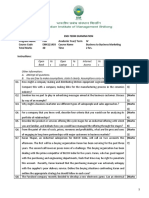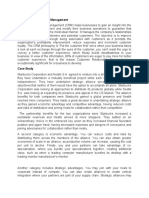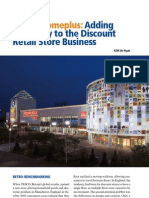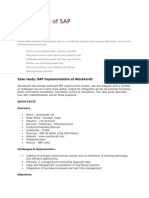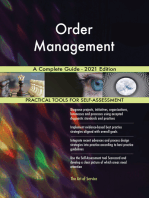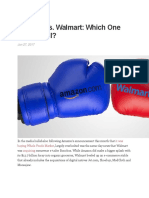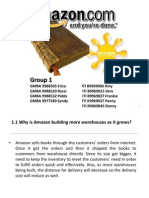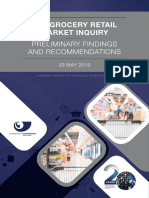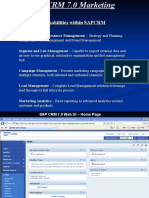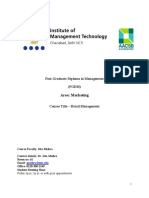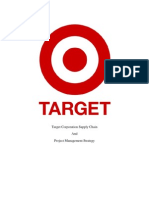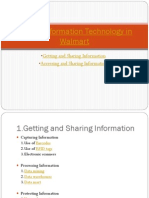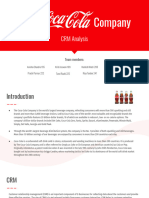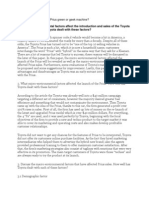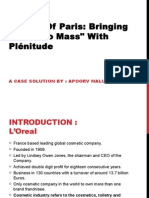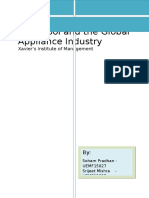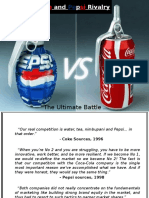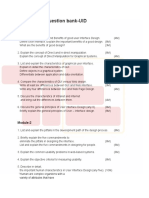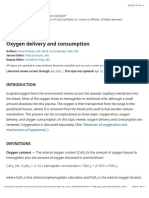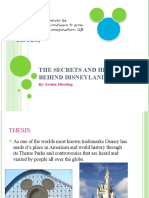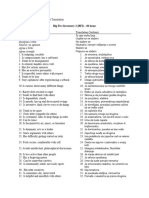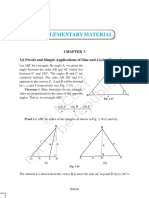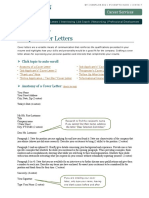Tesco CRM Report
Tesco CRM Report
Uploaded by
Soham PradhanCopyright:
Available Formats
Tesco CRM Report
Tesco CRM Report
Uploaded by
Soham PradhanOriginal Description:
Copyright
Available Formats
Share this document
Did you find this document useful?
Is this content inappropriate?
Copyright:
Available Formats
Tesco CRM Report
Tesco CRM Report
Uploaded by
Soham PradhanCopyright:
Available Formats
TESCO : CASE STUDY
Introduction :
Tesco is United Kingdoms (UK) largest retail industry (2003) in terms of market share as well as
in number of stores. It was setup in the year 1919 by Mr Jack Cohen as a grocery business in
London and by 2003 it was spreaded across 10 countries with 2291 stores and employing 2,
96,000 employees across these countries.
By understanding and adhering to its core purpose Creating value for customers, to earn their
lifetime loyalty, TESCO has proved itself as a pioneer in segmentation, targeting and positioning of
the customer need. Customer focussed approach in all its value systems is a key enabler in sustaining
its growing business.
Strategies adopted by Tesco:
1. Low Price Strategy : pile it high and sell it cheap
In order to reduce internal operation cost , TESCO in the year 1948 opened its first selfservice store in St Albans.
In 1960s due to Retail Price Maintenance (RPM) system, TESCO was unable to reduce the
price of products. Hence, in order to sustain its low price strategy, it started issuing Trading
stamps to customers which can be later redeemed in terms of discount or gifts.
In 1979, company successfully launched a price cutting campaign named Checkout at
Tesco.
Tesco, employed a dedicated team of employees, called Price Checkers, who
continuously review the market fluctuation in prices and provide inputs for every week
Pricing strategy. Comparative dynamic pricing gave a competitive edge.
2. Diversification strategy:
In 1974, Tesco has started operating petrol pumps.
In 1995, formed a joint venture with the Royal Bank of Scotland as Tesco Personal Finance
(TPF) ,that offered customers a wide variety of personal finance services.
In 1998, after the utilities business was deregulated in the UK, Tesco began offering electricity
and telecommunications products and services.
3. Focussed Market Strategy :
In 1990, Tesco came with three new formats stores based on location and product variety
requirements.
o Tesco Metro: To serve local community of region,
o Tesco Express: Combination of petrol pump & convenience store,
o Tesco Extra Store: Hypermarket focused equally on food and non-food merchandise.
Tesco realized that by identifying top customers ( Frequent buyers and amount spent ) and
targeting them will help in gaining more profit and customer loyalty. Hence to support this
initiative, it collaborated with Dunnhumby as a marketing consultant in 1994.
o With the help of data mining they analyzed the data and classified the customers into
four broad categories: Premium, Standard, Potential and Uncommitted.
CRM CASE STUDY
EMBA 2015-2016
SOHAM PRADHAN (UEMF15027)
o On the basis of type of products purchased customers were categorized along
dimensions such as, value, convenience, frozen, healthy eating, fresh and kids.
4. Customer Relationship Management Strategy:
Following are the various CRM initiatives undertaken by Tesco:
Training internal staff
o In 1993-94, Tesco launched the First Class Service. Under this initiative, the company
gave customer service training to over 90,000 store staff.
The company has distributed over 140,000 educational videos about the Club loyalty scheme at
various stores , inorder to make them the understand the purpose and out expected out of it.
o Impelemented Every Customer Offered Help (ECOH), inorder to have a standardized
support staff experience.
The segmentation helped in understanding the customer need and mass-customise the
magazine with reference to each group taste and references. This led to development of
around 1,50,000 variants of magazines with unique combination of articles, advertisements
related to its offerings, third party advertisements and tailored promotional coupons.
In 1994, company launched the One on Front scheme to reduce the time of customers at
check-out counters. Tesco store personnel ensure that if there was more than one person
at any counter will lead to open for the person second in line.
In 1995, Tesco launched the Clubcard Loyalty scheme. Through it company was able to
create its own customer database which became the primary data source for consumer
analysis.
Tesco began giving many special privileges, such as Valet parking and personal attention
from store managers to customers.
Special cards were created for students and mothers.
Special attention given to expectant mothers in the form of personal shopping assistants.
Tesco adopted the policy of offering its service to customers in innovative ways.
Instance: Tescooters (scooters) were purchased by the thailand customer and it was
delivered to their home.
In 2000, company tied up with a Safeway Inc to launch an online grocery shopping services
In 2003,Tesco launched a new initiative targeted at its women customers name Me Time.
It was offered ladies free sessions at leading health spas, luxury gyms and beauty saloons
and discounts on designers clothes, perfumes and cosmetics.
Benefits gained from the strategies
Over 20% Tesco coupons were redeemed as against industry standard of 0.5%.
Due to the captive customer base and the cross-selling opportunity, the cost of acquiring
customers for its financial service was 50% less.
Due to the data Tesco was able to offer better services to the customers.
Tesco was ensured that the footfalls in its stores did not decline on account of competitive
pressures.
Tesco developed a totally new product rage, Tesco Finest for the high income bracket
who are attracted by rivals.
Tesco, removed the impulsive products like candies from off-shelf still company earned
profit.
CRM CASE STUDY
EMBA 2015-2016
SOHAM PRADHAN (UEMF15027)
You might also like
- Capital One Case Study On CRMDocument3 pagesCapital One Case Study On CRMSoham PradhanNo ratings yet
- Marketing AldiDocument13 pagesMarketing AldiMd. Ariful Haque ChowdhuryNo ratings yet
- CVS Web Strategy - Write UpDocument3 pagesCVS Web Strategy - Write UpAswin Prakash T0% (1)
- Venky 3Document39 pagesVenky 3Uday GowdaNo ratings yet
- B2B END Term - 2020PGP054Document13 pagesB2B END Term - 2020PGP054Soham ChaudhuriNo ratings yet
- CRM and Case StudyDocument3 pagesCRM and Case StudyNJNo ratings yet
- Case Study - TESCO HomeplusDocument8 pagesCase Study - TESCO HomeplusrnsbakhietNo ratings yet
- Rebranding DSM CaseDocument3 pagesRebranding DSM CaseRohan GuptaNo ratings yet
- Advantages of SAP: Case Study: SAP Implementation at WockhardtDocument10 pagesAdvantages of SAP: Case Study: SAP Implementation at Wockhardtshai_m1No ratings yet
- Sample Strategic Plan 2Document5 pagesSample Strategic Plan 2ibrahimaktan100% (1)
- Dupont Strength and WeaknessDocument3 pagesDupont Strength and WeaknessAastha GargNo ratings yet
- Alibaba Brand AuditDocument19 pagesAlibaba Brand AuditTiviz Rooban100% (1)
- What Is Cross Docking You Say?Document3 pagesWhat Is Cross Docking You Say?Prasad GharatNo ratings yet
- Introduction To C&C: Cash and Carry (C&C) FormatDocument13 pagesIntroduction To C&C: Cash and Carry (C&C) FormatAmit RaykhereNo ratings yet
- Amazon-vs-Walmart-Omnichannel StrategyDocument7 pagesAmazon-vs-Walmart-Omnichannel StrategyPraveer BoseNo ratings yet
- MOB Project - Erste Group Transformation Case Analysis QuestionsDocument12 pagesMOB Project - Erste Group Transformation Case Analysis QuestionsSuperfresh LorthongNo ratings yet
- A Comprehensive Sales Plan Intended For Lipton Herbal Tea UnileverDocument13 pagesA Comprehensive Sales Plan Intended For Lipton Herbal Tea UnileverRakib ChowdhuryNo ratings yet
- Sostac 4 EnterpriseDocument5 pagesSostac 4 EnterprisenanapokuahNo ratings yet
- Altria GroupDocument3 pagesAltria Groupmonika sharmaNo ratings yet
- CRM Project Report SDocument11 pagesCRM Project Report SParas GuptaNo ratings yet
- ColgateDocument3 pagesColgateganal2girish0% (1)
- Operation MGT at TescoDocument7 pagesOperation MGT at TescoAl AminNo ratings yet
- Comparative Analysis of Operational Strategies Zara vs. H&M: Authors' NotesDocument6 pagesComparative Analysis of Operational Strategies Zara vs. H&M: Authors' NotesjunaidNo ratings yet
- Walmart 2Document6 pagesWalmart 2ShumailaNo ratings yet
- American Apparel Case Study 2Document2 pagesAmerican Apparel Case Study 2aamarketing0% (1)
- AmazonDocument9 pagesAmazonfaisal_csedu0% (1)
- Summer Training at BigBasketDocument5 pagesSummer Training at BigBasketPrateek ChaudhariNo ratings yet
- SfaDocument16 pagesSfabj3326No ratings yet
- OPM ReportDocument7 pagesOPM ReportMazhar AliNo ratings yet
- Case 3 - Sandra - CompetitionDocument2 pagesCase 3 - Sandra - CompetitionMINH Trần ThịNo ratings yet
- Engineering Viral Marketing: ECDM (Group 3) : Case Study PresentationDocument15 pagesEngineering Viral Marketing: ECDM (Group 3) : Case Study PresentationShaan RoyNo ratings yet
- Sales Organization StructureDocument27 pagesSales Organization Structureeunice oforiwaa appiahNo ratings yet
- IKEA in ChinaDocument11 pagesIKEA in ChinaMetta YunitaNo ratings yet
- Grocery Retail Market Inquiry SumaryDocument20 pagesGrocery Retail Market Inquiry SumaryKatlego MaileNo ratings yet
- SAP CRM 7.0 MarketingDocument26 pagesSAP CRM 7.0 MarketingKamlesh PillaiNo ratings yet
- Case Study #7 M&M 26.10.2013Document3 pagesCase Study #7 M&M 26.10.2013paw27No ratings yet
- Area: Marketing: Post-Graduate Diploma in Management (PGDM)Document5 pagesArea: Marketing: Post-Graduate Diploma in Management (PGDM)PrakharNo ratings yet
- This Study Resource Was Shared ViaDocument9 pagesThis Study Resource Was Shared ViaShivam TiwariNo ratings yet
- EMBA 632 - Group 02 Assignment - Amazon Case StudyDocument20 pagesEMBA 632 - Group 02 Assignment - Amazon Case StudyniradhNo ratings yet
- Walmart Case Study G2Document7 pagesWalmart Case Study G2Nawress SabriNo ratings yet
- Product LineDocument17 pagesProduct LineKirit DesaiNo ratings yet
- Target Corporation Supply ChainDocument3 pagesTarget Corporation Supply ChainJanine OnealNo ratings yet
- Marketing When Customer Equity MattersDocument2 pagesMarketing When Customer Equity MattersDevante DixonNo ratings yet
- Role of IT in WalmartDocument19 pagesRole of IT in Walmartshah_jalpan92911No ratings yet
- Selling at ServiceBox (A) - Jon Cliffords PerspectiveDocument8 pagesSelling at ServiceBox (A) - Jon Cliffords PerspectiveFanuser DNo ratings yet
- Keda ERP Implementation Case SolutionDocument12 pagesKeda ERP Implementation Case SolutionPraveen Kumar67% (3)
- Opening Case How Starbucks Is Changing To A Digital and Social EnterpriseDocument3 pagesOpening Case How Starbucks Is Changing To A Digital and Social Enterpriseleeyaa aNo ratings yet
- Mikes Bikes Final Report Megan EditedDocument29 pagesMikes Bikes Final Report Megan Editedkjamd2No ratings yet
- CaseStudy SupplyChainIntegration Nike Retail Brazil DHLDocument2 pagesCaseStudy SupplyChainIntegration Nike Retail Brazil DHLKarishma MittalNo ratings yet
- Bazaar ProjectDocument14 pagesBazaar ProjectSyeda AqsaNo ratings yet
- Evaluating Communication Strategies of International BusinessDocument13 pagesEvaluating Communication Strategies of International BusinessPrachi AgarwalNo ratings yet
- Asda Case StudyDocument2 pagesAsda Case StudyBreathing BuildingsNo ratings yet
- The Coca-Cola Company CRM AnalysisDocument16 pagesThe Coca-Cola Company CRM Analysistanvi100% (1)
- Marketing Report - J.Crew LudlowDocument9 pagesMarketing Report - J.Crew LudlowElizabethKyiNo ratings yet
- Marketing Across BoundariesA2Document4 pagesMarketing Across BoundariesA2AluNo ratings yet
- Company Case 4 Toyota Prius Green or Geek MachineDocument4 pagesCompany Case 4 Toyota Prius Green or Geek MachineMijo JurićNo ratings yet
- L'Oreal of Paris: Bringing "Class To Mass" With Plénitude: A Case Solution By: Apoorv MaluDocument14 pagesL'Oreal of Paris: Bringing "Class To Mass" With Plénitude: A Case Solution By: Apoorv MaluKumarNo ratings yet
- Omfed ReportDocument45 pagesOmfed ReportSoham Pradhan67% (3)
- Hired or FiredDocument26 pagesHired or FiredSoham PradhanNo ratings yet
- Whirlpool and The Global Appliance IndustryDocument6 pagesWhirlpool and The Global Appliance IndustrySoham Pradhan100% (1)
- A Case Study On Sudhir Telang Machinery Equipment CompanyDocument11 pagesA Case Study On Sudhir Telang Machinery Equipment CompanySoham Pradhan100% (1)
- Capital OneDocument5 pagesCapital OneSoham PradhanNo ratings yet
- Sustainabiity ManagementDocument14 pagesSustainabiity ManagementSoham PradhanNo ratings yet
- The Coke and Pepsi Rivalry - ModifiedDocument19 pagesThe Coke and Pepsi Rivalry - ModifiedSoham PradhanNo ratings yet
- Capital OneDocument3 pagesCapital OneSoham PradhanNo ratings yet
- ST D SouzaDocument1 pageST D SouzaSoham PradhanNo ratings yet
- Question bank-UIDDocument4 pagesQuestion bank-UIDNikhil kumarNo ratings yet
- Pakistan Tobacco CompanyDocument23 pagesPakistan Tobacco CompanyMohsen SirajNo ratings yet
- Goosebumps The Curse of The Mummy39s Tomb ReviewDocument3 pagesGoosebumps The Curse of The Mummy39s Tomb ReviewLisaNo ratings yet
- Validação Tfeq-R21Document7 pagesValidação Tfeq-R21ANDRESSA PORTONo ratings yet
- Ethiopian Coffee Buying Guide PDFDocument90 pagesEthiopian Coffee Buying Guide PDFchill mainNo ratings yet
- Ancient Civilizations Project 2014Document10 pagesAncient Civilizations Project 2014Mariana SantolinNo ratings yet
- Vsfiltermod Tags NuevasDocument6 pagesVsfiltermod Tags NuevasASEDARKNo ratings yet
- Segundo ParcialDocument16 pagesSegundo ParcialDudley GomezNo ratings yet
- General Health Profiling StudentsDocument1 pageGeneral Health Profiling StudentsMohammad Matte UllahNo ratings yet
- Report On MSMEDocument27 pagesReport On MSMERohit Gupta50% (2)
- Tata Case SolutionDocument10 pagesTata Case Solutionshantanu_malviya_1100% (1)
- K Kishan V Vijay Nirman Company LTDDocument12 pagesK Kishan V Vijay Nirman Company LTDR100% (1)
- Black Spots in Cat AnusDocument7 pagesBlack Spots in Cat AnusjaubbersuggestNo ratings yet
- LT Teacher Computer Science BookDocument70 pagesLT Teacher Computer Science BookraghaveshideaNo ratings yet
- Agabon v. NLRC DigestDocument3 pagesAgabon v. NLRC DigestHandeskyNo ratings yet
- Intelligence - Measurement, Multiple Intelligences, Myths, Mysteries, and Realities, Triarchic Theory of Intelligence - EMOTIONAL INTELLIGENCEDocument4 pagesIntelligence - Measurement, Multiple Intelligences, Myths, Mysteries, and Realities, Triarchic Theory of Intelligence - EMOTIONAL INTELLIGENCEYasmeen JafferNo ratings yet
- Pandoc User's GuideDocument50 pagesPandoc User's Guidemiguelhernandez199No ratings yet
- SRSDocument42 pagesSRSDr. Mahmoud AljawarnehNo ratings yet
- Oxygen Delivery and Consumption - UpToDateDocument15 pagesOxygen Delivery and Consumption - UpToDateValerie ZimmermannNo ratings yet
- Eip Annotated BibliographyDocument5 pagesEip Annotated Bibliographyapi-384869872No ratings yet
- The Secrets and History Behind DisneylandDocument17 pagesThe Secrets and History Behind DisneylandsmartshrNo ratings yet
- Big Five Inventory-2 (Serbian)Document3 pagesBig Five Inventory-2 (Serbian)milorad krusicaNo ratings yet
- Supplementary Material: 3.6 Proofs and Simple Applications of Sine and Cosine FormulaeDocument21 pagesSupplementary Material: 3.6 Proofs and Simple Applications of Sine and Cosine Formulaegowtham samNo ratings yet
- Workshop Future TenseDocument2 pagesWorkshop Future TenseAndrés Felipe Rojas AlvarezNo ratings yet
- Exploring The Legality of Arbitration in Intellectual Property DisputesDocument17 pagesExploring The Legality of Arbitration in Intellectual Property DisputesAustin TirkeyNo ratings yet
- Radiography Sample Cover Letters: Ø Click Topic To Auto-ScrollDocument8 pagesRadiography Sample Cover Letters: Ø Click Topic To Auto-Scrollidin ahmadNo ratings yet
- Academic PressureDocument42 pagesAcademic PressureJohnjohn MateoNo ratings yet
- Cost II Chapter ThreeDocument11 pagesCost II Chapter ThreeSemira100% (1)
- Initial Public Offerings An Issuers Guide 1Document105 pagesInitial Public Offerings An Issuers Guide 1Milos MilosNo ratings yet
- ADH8066 GSM Module AT-Commands v1.6Document79 pagesADH8066 GSM Module AT-Commands v1.6_Nishant_No ratings yet




